Notts County’s rise from National League promotion contenders to League Two promotion contenders in such a quick time frame is impressive, and a lot of that success is a result of the tactical identity that Luke Williams built at the club prior to his move to Championship club Swansea City. We’ve covered how the Magpies looked when playing under Williams’ tactics, so we know all about the details within their possession-based approach. Finding Williams’ successor was a task that required thorough research to get the right coach for the job, but the club also had to act quickly, given that we are midway through the domestic season.
The man deemed the perfect Williams replacement by Notts County is Stuart Maynard, who joined the club after being at the non-league club Wealdstone FC for three years. Maynard has transformed Wealdstone into a highly respected possession-based side in the National League after he helped guide the club to their best league finish in decades. This scout report will provide a tactical analysis of Maynard’s tactics at Wealdstone, looking at why he fits the mould of Notts County’s philosophy.
Manager Overview
43-year-old Stuart Maynard started his coaching journey back in 2012 when he became assistant manager to former teammate Dean Brennan at Hemel Hempstead Town. The management duo tasted quick success by winning a league title and guiding the club to the FA Cup first round proper. Maynard and Brennan struck a very strong partnership as coaches, and this reflected in the successes they had in the years to come, having stints at a few other non-league clubs along the way.
In May 2019, the duo joined Wealdstone, with the club in the National League South at the time. They’d been floating around mid-table for the previous few seasons, but Maynard and Brennan delivered the league title in 2019/20 (the season that was shortened due to COVID). This would be the first time Wealdstone had been in the National League since the 80s. In February of the 2020/21 campaign, Brennan left the club to take charge at Barnet – Maynard broke the cycle, effectively ending the duo’s long-standing coaching partnership after he was appointed as interim manager of Wealdstone, before being appointed the club’s permanent manager shortly after.
Despite a rocky start to life as Wealdstone manager, with some painful defeats, Maynard was able to guide the club to safety – finishing 19th. 2021/22 was his first full season in charge of the Stones, and he bettered the previous record by finishing 16th – the club’s highest league position in 35 years. Last season, which also turned out to be his final full season at the club, he guided them to an impressive 13th-place finish. He left with the club in 14th place this season, but his possession-based tactics caught the eye of non-league and EFL followers and, when needed, caught the eye of the Notts County hierarchy.

As we will come to find out in this analysis, Maynard’s tactics – the philosophy behind them, align nicely with what Luke Williams had built prior. Three critical factors are worth keeping in mind. However – Maynard was operating with a lower budget and (arguably) a lower quality of personnel within his squad at Wealdstone, compared to what he will have at County and what Williams had there, too. Thirdly, while the two coaches share some similarities in the foundations of their tactics, this, of course, is not an identical replacement, and Maynard will certainly look to bring his own ideas to the table.
The tactical similarities were undoubtedly a contributing factor to his appointment at Meadow Lane, with Maynard utilising similar formations to Notts County this season, as you can see above. While similar formations don’t always mean similar tactical approaches, in this case, they do, and finding a manager who won’t want to make wholesale changes to the shape or system is essential as the County players will be used to playing certain roles in a certain formation.
Possession domination – fitting the Notts County mould
This season, Notts County have been excellent in attack, scoring more goals than anyone in League Two, and it’s no coincidence that they also have the highest average possession in the division too (66.6%), so it makes sense that they wanted to bring in a manager that can bring some element of tactical continuity following Williams’ departure. This season, Maynard’s Wealdstone average 58.5% possession – the National League’s fourth-highest average – this segment of analysis will look at how Wealdstone’s possession-based approach looked.
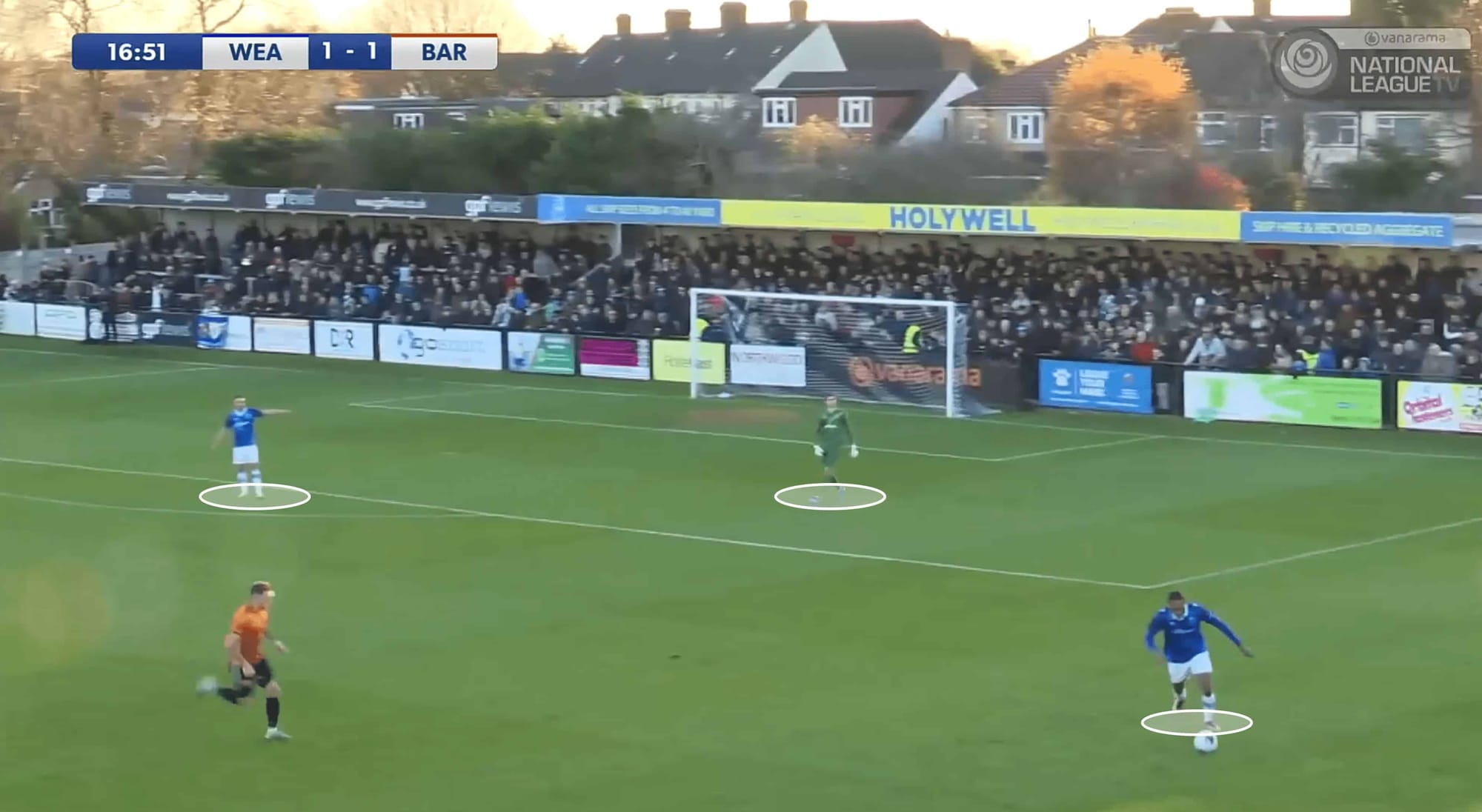
Playing out from the back was the primary aim of the early build-up phases in Maynard’s tactics at Wealdstone, looking to use a wide back three to move the ball into midfield areas. The image above gives us an idea of the width they’d generally apply in these areas – the off-screen RCB would typically be in a similar position to the LCB on his side of the pitch. The width of the back three would set the tone in terms of how Wealdstone looked to stretch the pitch before zoning in on one area further up the pitch.
When thinking about how they would usually move the ball from the position above, there are a few possibilities at hand. Of course, the CB and even the GK act as options to recycle the possession if Wealdstone want to play it safe and restart. In terms of options further up the pitch, the wing-backs would often be high up the pitch, so they were not always available. Instead, playing passes into midfield were an essential aspect of their tactics – they were also no stranger to playing a ball in behind the opposition defence for a forward to run on to, something which would suit the pace of Macauley Langstaff well.
We’ll touch on their passing variety later, but in terms of their overall passing numbers, we see proof of the possession-based system and their capability to play that way. Wealdstone make an average of 442.96 passes per 90 (third-highest in NL), which comes with an accuracy rate of 83.9% (fourth-highest).
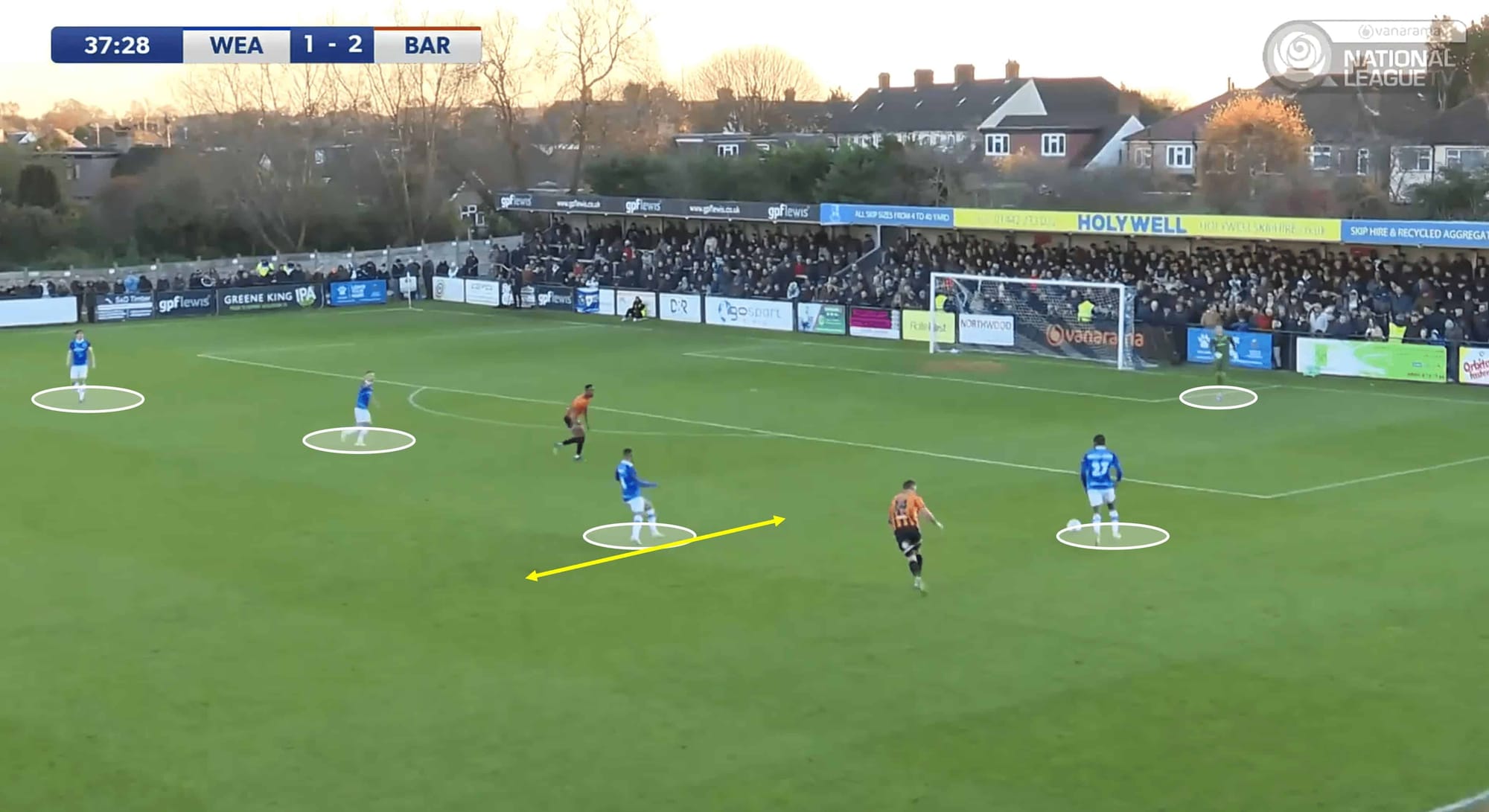
Here, we can assess the role of a midfielder in the early stages of possession, as there are a few variations of involvement. In some moments, he would drift in from a higher position to offer that deep DM option, similar to what he shows in the image above. In other times, particularly when possession was more comfortable, allowing the wide CBs to be higher up, he would drop in, essentially creating a momentary back four – the wide CBs almost playing as full-backs and the wing-backs playing as wingers. This kind of formation fluidity was important to Maynard’s tactics, and the supporting role of the DM is something we’ll likely see from Maynard’s Notts County, too.
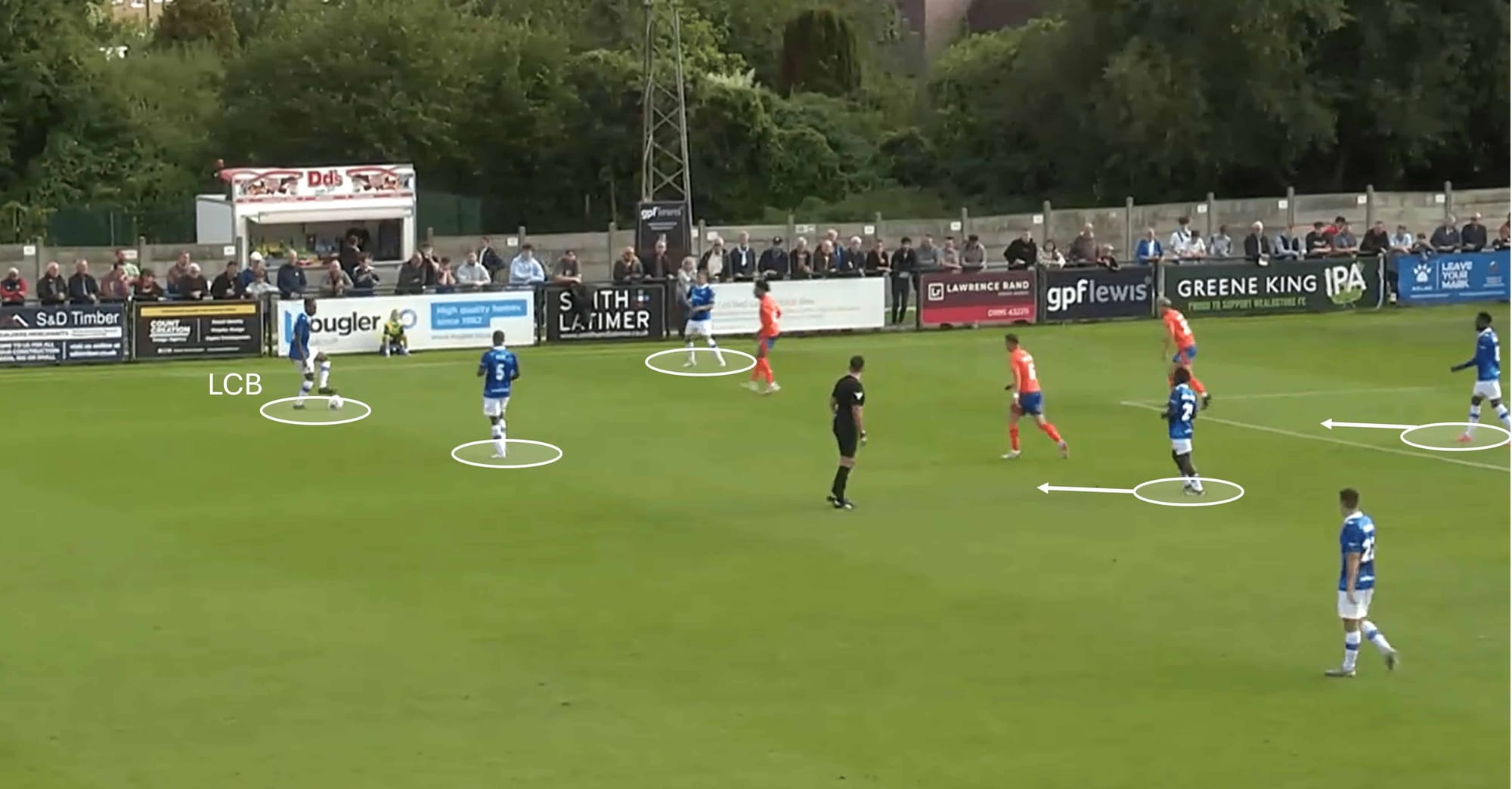
Once Wealdstone successfully shifted possession towards the final third, we’d see the creation of an overload in zones similar to what you see in the image above. The wide CB pushes forward to create a solid numerical presence along with the WB and a close midfielder – more midfielders and a forward would also usually drift into supporting positions to increase the unpredictability of the attack.
You’ll notice how this, in some ways, mirrors how Notts County played under Williams, with wide CBs Kyle Cameron and Richard Brindley being more than accustomed to pushing into midfield zones to add an extra body to the possession.
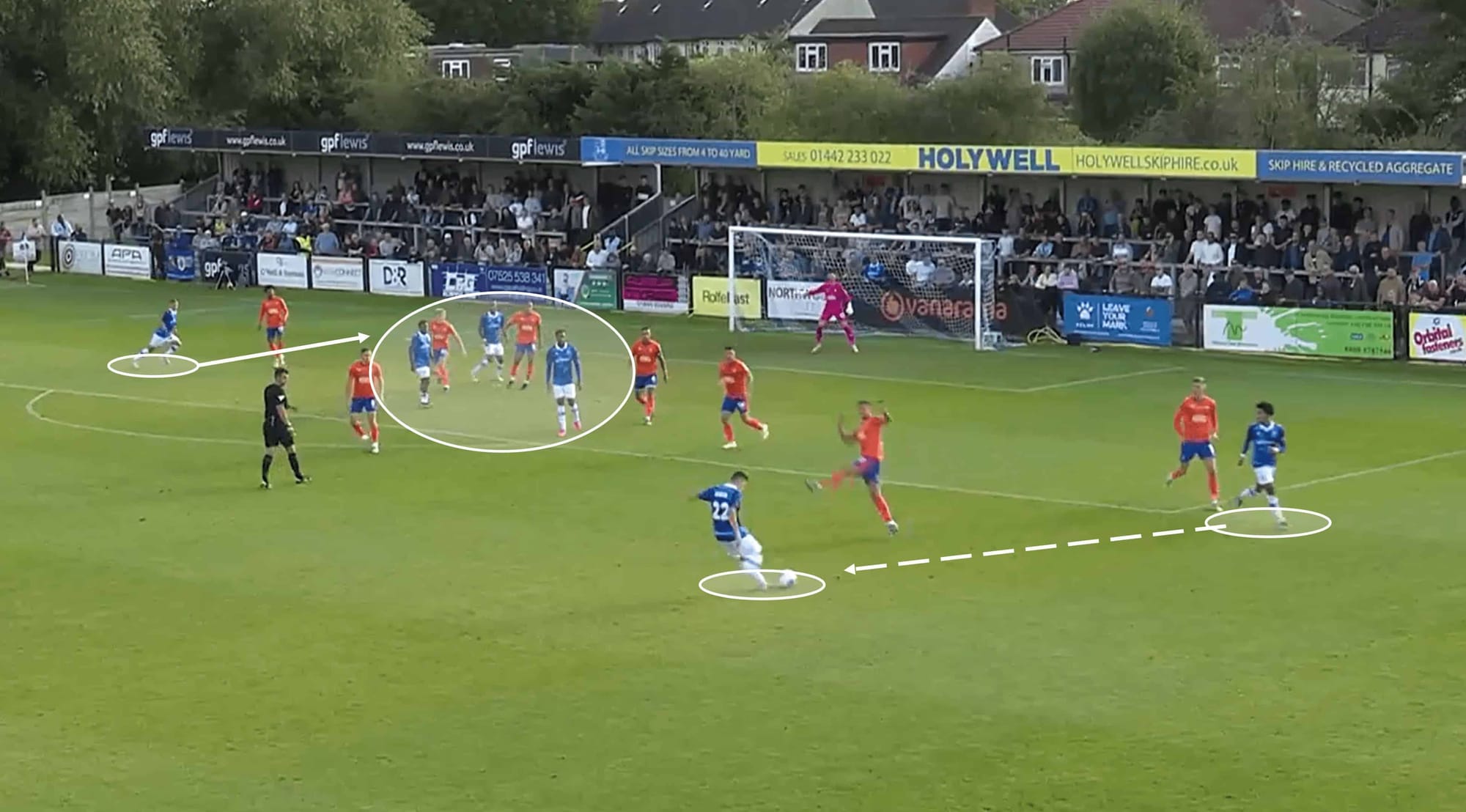
Once Wealdstone reached the final third there was room for more freedom and fluidity; playing in reaction to what is available in that game, looking to generate attacking chances in various ways from week to week. Crossing may not have been one of the more frequent elements of their attacking tactics, averaging 14.18 crosses per 90 (10th highest in NL). Still, they had the ability to be very effective with them, as evidenced by their cross accuracy of 33.3% (sixth-highest in NL).
This was helped by a heavy attacking presence in the box and well-timed runs from certain areas in there, giving the crosser plenty to aim at and the defence plenty to think about. This is another element that we see being utilised well at County, especially in recent weeks, with both wingers, particularly Jodi Jones, creating plenty of chances from wide areas.
One thing that could be difficult to transfer into a higher league is Maynard’s tendency to give his players attacking freedom in the sense of how often they dribble. Under his management, Wealdstone attempted 28.35 1v1s and dribbles per 90, the highest average in the National League, which just tells us that Maynard likes to involve his technical players in attacking moments wherever possible.
Another noteworthy element of Maynard’s tactics this season was, although his side were undoubtedly a possession-based team, they had a excellent aspect of versatility about them in terms of how they executed a build-up – averaging 73.19 progressive passes per 90 highlighting the hunger to move the ball forward quickly where possible. Being quick in possession was important for the stones, as evidenced by their passing rate of 13.7 (NL’s 7th highest). This meant that off-the-ball movement had to be ongoing and creative.
This tactical fluidity and versatility – exploring different methods of moving possession forward instead of being more one-dimensional and rigid in a tactical sense served them well. Sure, they struggled for goals, but the stats don’t lie – 12.79 shots per 90 (NL’s 3rd highest average) and 17.8 touches in the box per 90 (6th highest) tells us that they were performing effectively.
Defensive discipline
It is no secret that Notts County have had defensive issues this season, which were likely outlined as a key area for Maynard to focus on in his opening months at the Magpies. In 25 National League games this season, Wealdstone have conceded 36, one of the best defensive records in that division – a significant improvement on their defensive output last season. Here, we look at what tactical elements Maynard may look to implement with the aim of shoring up County’s defence.
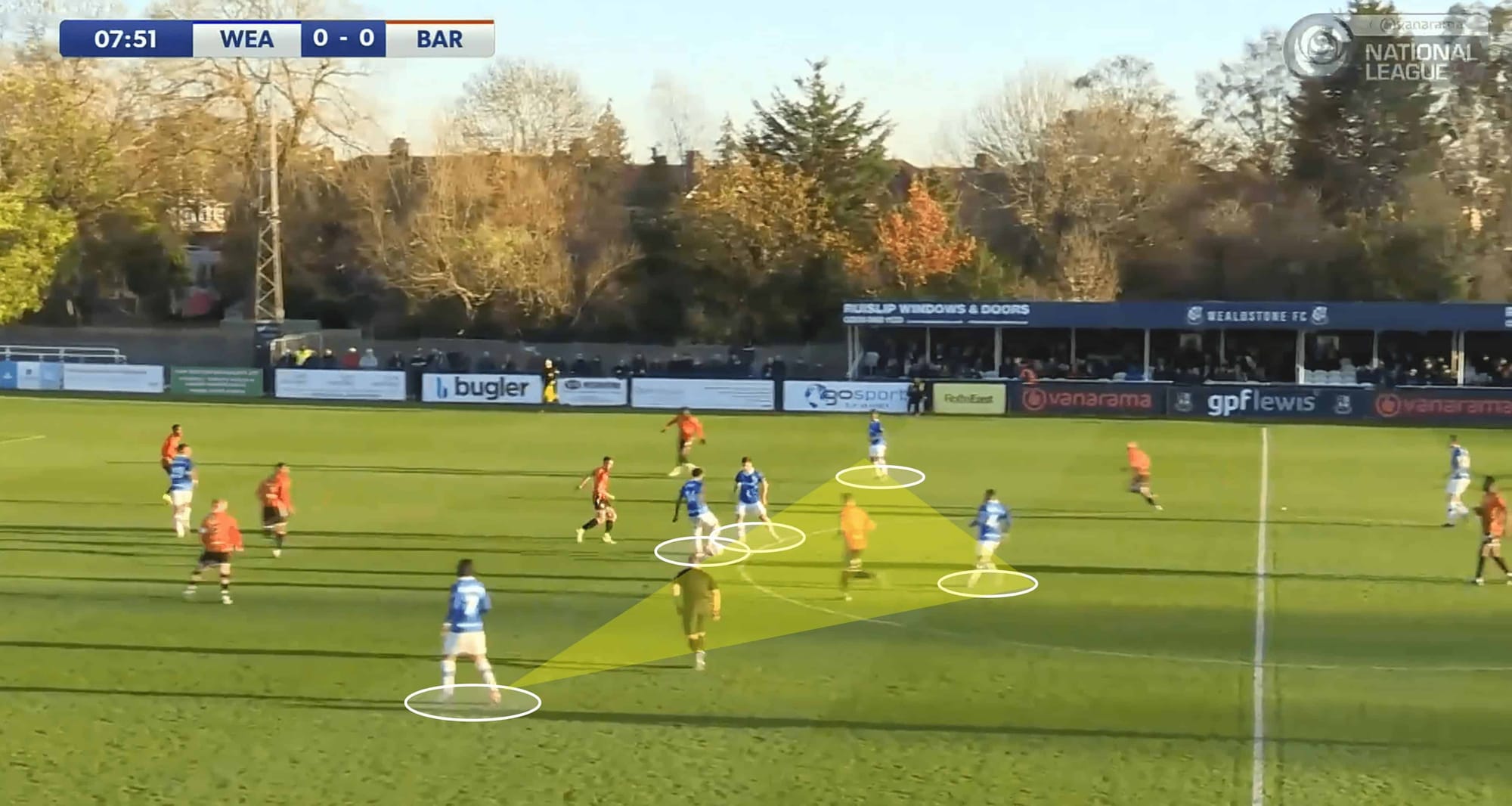
While this image shows us a moment where Wealdstone had possession, the tactical set-up has important defensive implications. For context, the midfield were in this high position after a Wealdstone CB sent the ball long with the ball eventually finding its way to where you see it above. The important note here is that while the ball was travelling toward the Banet back line, Wealdstone’s midfield were in a high position.
This high position gives Wealdstone the upper hand whether they win the first/second ball or not. If they win that exchange, they have the midfield ready to add a dangerous attacking presence instantly: if Barnet win that first/second ball, the high Wealdstone midfield is prepped and ready to execute a counter-press in quick fashion, giving the opposition very little chance of getting out without simply clearing their lines.
The narrow shape of the entire midfield unit (including the wing-backs) is also important, squeezing that central space to make it harder for the opposition to operate in. This defensive measure taken to combat counterattacks is the kind of defensive detail and discipline County need to improve their defensive performance.
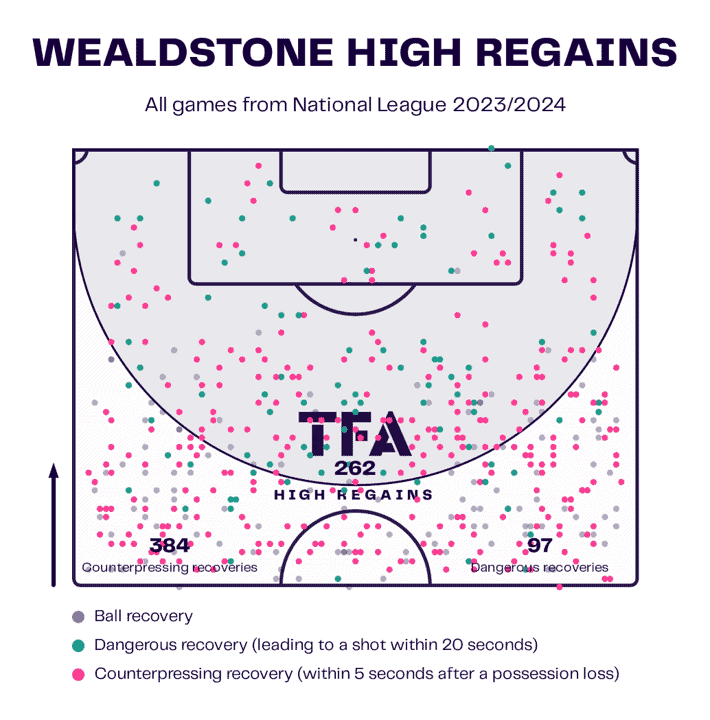
Pressing was another key aspect of Wealdstone’s tactics under Maynard. We will dive into when and where they looked to execute a press, right after we discuss the numbers behind their off-the-ball tactics. As you can see from the stats in the visual, Wealdstone have been very active in their approach out of possession, with a pleasing frequency of dangerous recoveries in particular.
Other stats that solidify their title of being a strong pressing team under Maynard come in the form of PPDA and challenge intensity. Their PPDA rate of 10.09 is the 10th highest in the National League, while their challenge intensity of 6.4 (6th highest in NL) highlights their intensity in the press.
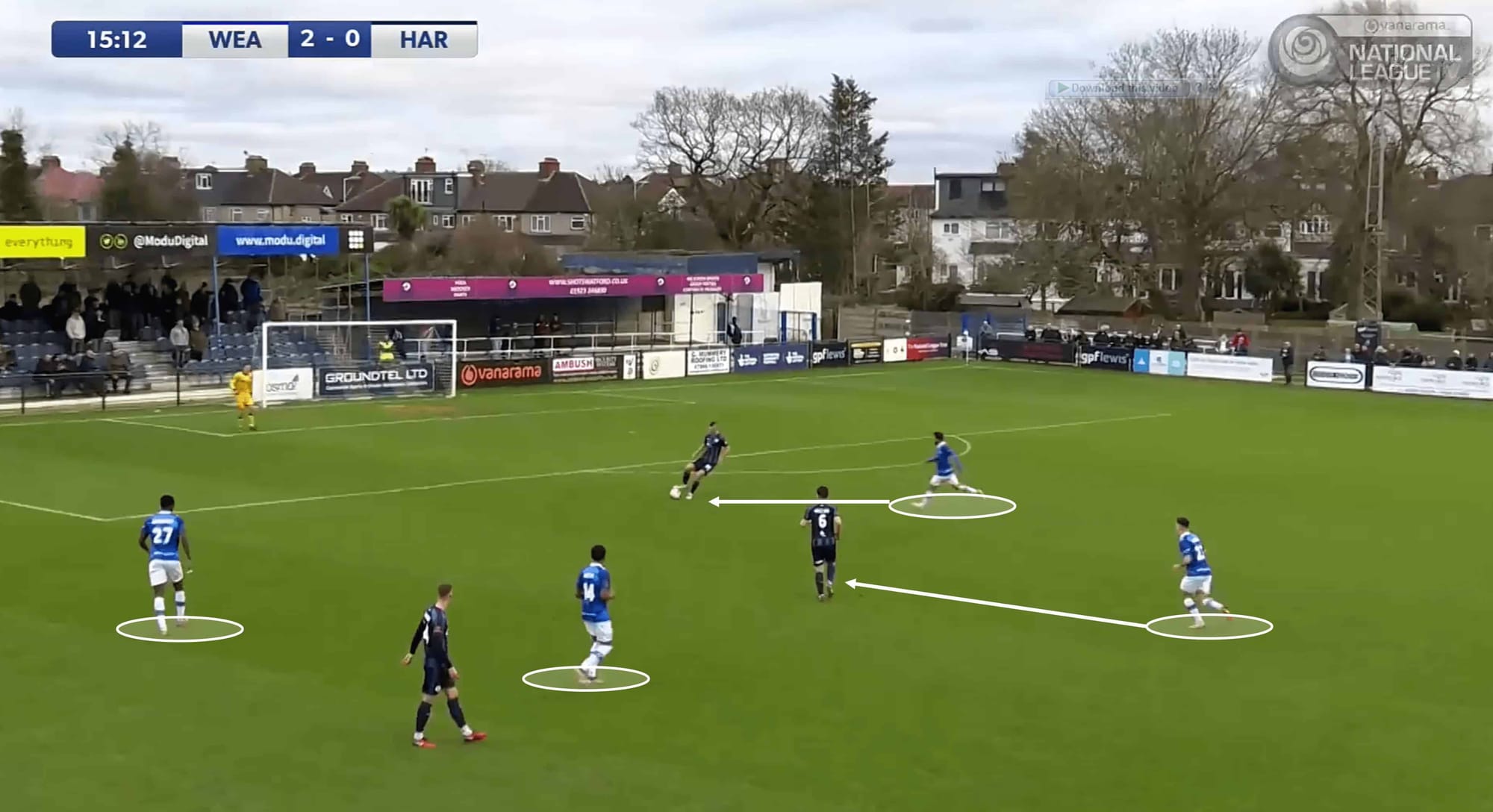
Typically, Wealdstone would not press the opposition backline without the presence of a pressing trigger – in this case, it was a visible uncertainty on the ball from the opposition followed by a lacklustre backwards pass. Support in the press is provided by a midfielder or two, increasing the Stones’ presence in the opposition’s proximity, making it severely difficult to play their way out of danger without risking giving the ball away in a threatening area.
The timing of the press, in terms of not just relentlessly pressing whenever they don’t have the ball, is again the level of tactical detail that Notts County require. That isn’t to say Luke Williams did not possess attention to detail, but a fresh perspective on their defensive approach could be the shakeup that the Magpies need.
So, what happens when Wealdstone aren’t pressing as a result of an apparent trigger? They’ll apply a mid-block when the opposition has comfortable possession, waiting for that pass into midfield to come. As soon as it does, the Stones’ midfield pounces, squeezing space and pressing the ball with great intensity.
Conclusion
Losing a coach of Luke Williams’ quality initially seemed like a backwards step; a hurdle for Notts County. But after acquiring Stuart Maynard, there is no reason for fans to be excited about their future. Time will tell whether Maynard can adjust quickly to EFL football, and it will be interesting to see how he implements the tactics we’ve discussed in this analysis. While it may take a while to see Maynard’s tactical imprint clearly, the similarities in tactical foundations will certainly help – in truth, there are very few managers/coaches in non-league operating at the level Maynard was, that also match the Notts County tactical blueprint.

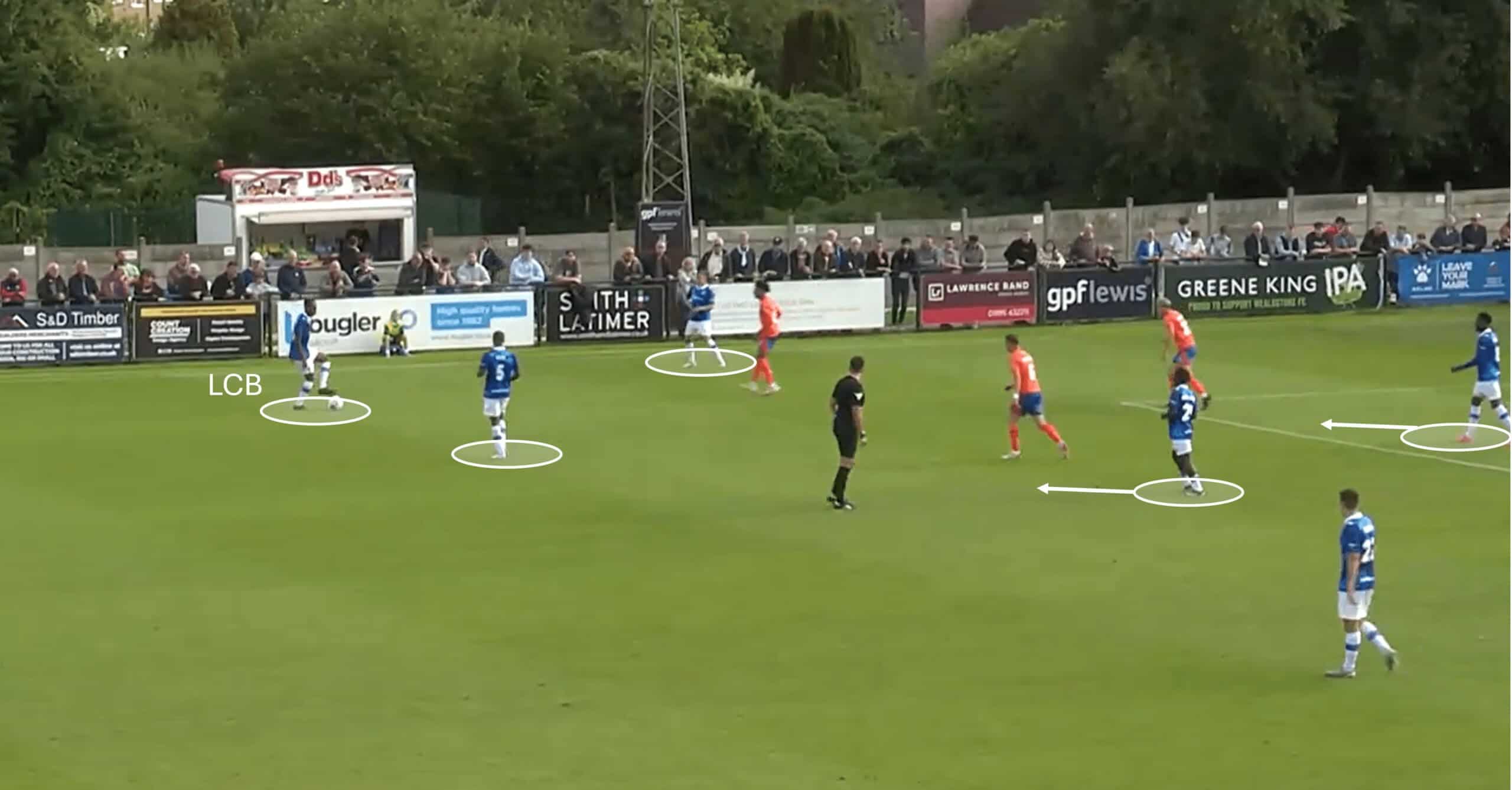




Comments